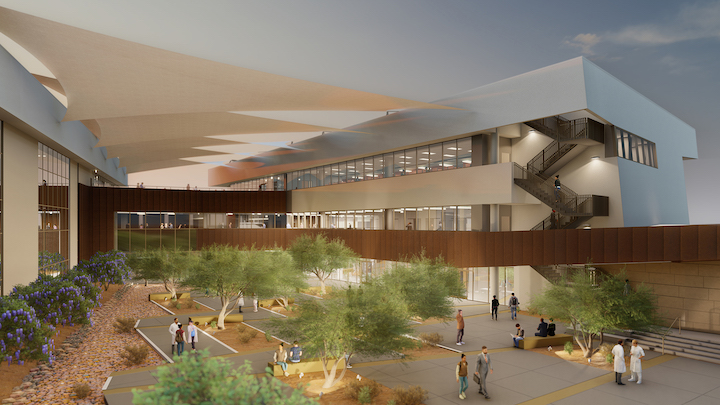
Mayo Clinic first arrived in Arizona in the late 1980s with the opening of its Scottsdale hospital. About a decade later, the Minnesota-based medical institution opened a second Arizona hospital in north Phoenix, and in 2017, welcomed students to the Arizona campus of the Mayo Clinic Alix School of Medicine.
In 2002, the Flinn Foundation launched Arizona’s Bioscience Roadmap, which has guided the state’s growth in the biosciences over the past two decades. Mayo Clinic’s presence in Arizona has played a critical role in the success of the Roadmap, and will continue to do so with the creation of a new hub of bioscience innovation and Mayo’s ongoing partnership with Arizona State University.
Shortly after Mayo Clinic expanded into Arizona, Dr. Michele Halyard headed west as well. Today, the practicing radiation oncologist serves as the Suzanne Hanson Poole Vice Chair, Mayo Clinic School of Medicine, and Dean of the Arizona campus.
The medical school campus adds about 50 medical students per year from both Arizona and around the country. And their education is not limited to a classroom or hospital setting, but includes time serving in clinics providing care to refugees and other vulnerable populations.
Dr. Halyard said the Mayo Clinic Alix School of Medicine is distinctive as it’s one school in three locations, with a small class size and high faculty-to-student ratio providing students mentorship, sponsorship, and research opportunities.
The Scottsdale campus of the Mayo Clinic Alix School of Medicine has a unique partnership and collaboration with Arizona State University, which offers dual degrees for Mayo medical students, including a Master of Science in the science of health care delivery, a law degree, and an MBA.


Mayo Clinic is investing nearly $750 million to double the size of its Phoenix campus, increasing patient care, education, and research capabilities, including the new Integrated Education and Research Building. Dr. Halyard said the organization plans to add more than 2,000 employees, making the campus a hub of biomedical science and technology innovation that will hopefully attract companies and industry from outside Arizona.
Over the next 20 years, Dr. Halyard hopes to see modest further growth on the medical school’s Scottsdale campus, with its students choosing to practice in Arizona. She also hopes to see graduates become leaders in medicine and be the innovators and changemakers for improvement.